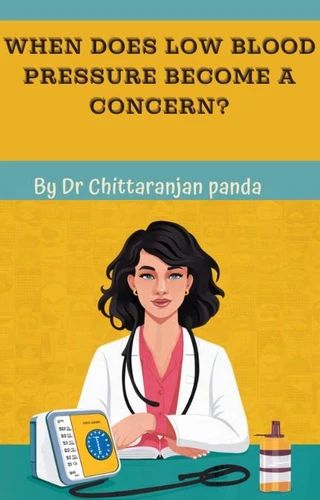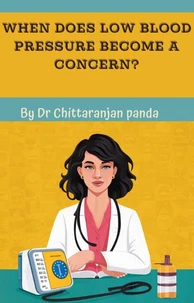- Accueil /
- Dr Chittaranjan Panda
Dr Chittaranjan Panda

Dernière sortie
When Does Low Blood Pressure Become a Concern?
When Does Low Blood Pressure Become a Concern?Not all low blood pressure readings are cause for alarm. In fact, some people naturally have lower blood pressure than others and experience no negative effects. However, low blood pressure can become a concern when it starts to impact your daily life or triggers specific symptoms. This section will delve into the key factors that turn low blood pressure from a simple reading to a potential health issue.
We'll explore:The presence of symptoms: Dizziness, lightheadedness, fainting, nausea, fatigue, and blurred vision are all red flags that your blood pressure may be dipping too low and affecting your body's ability to function normally. The severity of the blood pressure reading: While the general threshold for low blood pressure is below 90/60mmHg, a sudden or significant drop from your usual reading can be more concerning than a consistently low number.
Underlying health conditions: Certain medical conditions can make low blood pressure more problematic. We'll discuss how pre-existing heart problems, neurological disorders, or severe infections can heighten the concern surrounding low blood pressure readings. By understanding these factors, you'll be better equipped to identify when low blood pressure might require a doctor's evaluation and how to distinguish between normal variations and potentially risky drops.
We'll explore:The presence of symptoms: Dizziness, lightheadedness, fainting, nausea, fatigue, and blurred vision are all red flags that your blood pressure may be dipping too low and affecting your body's ability to function normally. The severity of the blood pressure reading: While the general threshold for low blood pressure is below 90/60mmHg, a sudden or significant drop from your usual reading can be more concerning than a consistently low number.
Underlying health conditions: Certain medical conditions can make low blood pressure more problematic. We'll discuss how pre-existing heart problems, neurological disorders, or severe infections can heighten the concern surrounding low blood pressure readings. By understanding these factors, you'll be better equipped to identify when low blood pressure might require a doctor's evaluation and how to distinguish between normal variations and potentially risky drops.
When Does Low Blood Pressure Become a Concern?Not all low blood pressure readings are cause for alarm. In fact, some people naturally have lower blood pressure than others and experience no negative effects. However, low blood pressure can become a concern when it starts to impact your daily life or triggers specific symptoms. This section will delve into the key factors that turn low blood pressure from a simple reading to a potential health issue.
We'll explore:The presence of symptoms: Dizziness, lightheadedness, fainting, nausea, fatigue, and blurred vision are all red flags that your blood pressure may be dipping too low and affecting your body's ability to function normally. The severity of the blood pressure reading: While the general threshold for low blood pressure is below 90/60mmHg, a sudden or significant drop from your usual reading can be more concerning than a consistently low number.
Underlying health conditions: Certain medical conditions can make low blood pressure more problematic. We'll discuss how pre-existing heart problems, neurological disorders, or severe infections can heighten the concern surrounding low blood pressure readings. By understanding these factors, you'll be better equipped to identify when low blood pressure might require a doctor's evaluation and how to distinguish between normal variations and potentially risky drops.
We'll explore:The presence of symptoms: Dizziness, lightheadedness, fainting, nausea, fatigue, and blurred vision are all red flags that your blood pressure may be dipping too low and affecting your body's ability to function normally. The severity of the blood pressure reading: While the general threshold for low blood pressure is below 90/60mmHg, a sudden or significant drop from your usual reading can be more concerning than a consistently low number.
Underlying health conditions: Certain medical conditions can make low blood pressure more problematic. We'll discuss how pre-existing heart problems, neurological disorders, or severe infections can heighten the concern surrounding low blood pressure readings. By understanding these factors, you'll be better equipped to identify when low blood pressure might require a doctor's evaluation and how to distinguish between normal variations and potentially risky drops.
Les livres de Dr Chittaranjan Panda

Lifestyle Choices and Breast Cancer Risk: Making Informed Decisions. Health, #18
Dr Chittaranjan Panda
E-book
1,99 €

8,49 €

4,99 €

8,49 €

8,49 €

Say Goodbye to Backaches: Your Guide to Healthy Sitting Habits. Health, #12
Dr Chittaranjan Panda
E-book
8,49 €

4,99 €

Managing Common Aches and Pains in Kids: A Parent's Handbook. Health, #9
Dr Chittaranjan Panda
E-book
8,49 €

Nourishing Your Child: A Guide to Overcoming Eating Problems. Health, #11
Dr Chittaranjan Panda
E-book
8,49 €

6,49 €

Understanding Cancer: A Comprehensive Guide to Different Types and Risk Factors. Health, #6
Dr Chittaranjan Panda
E-book
8,49 €

8,49 €

The Essential Guide to Routine Blood Tests for General Health. Health, #2
Dr Chittaranjan Panda
E-book
4,99 €
